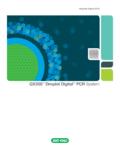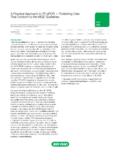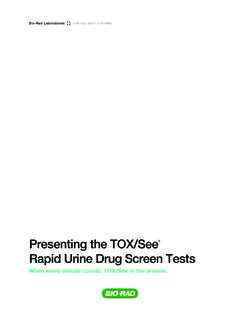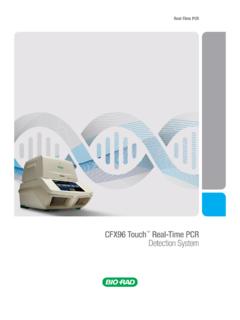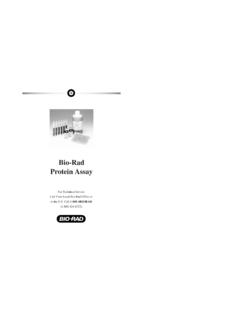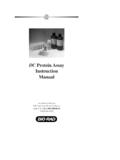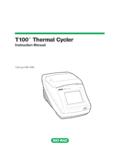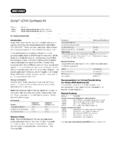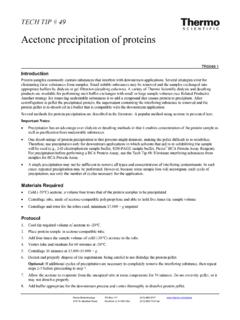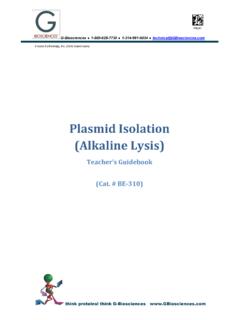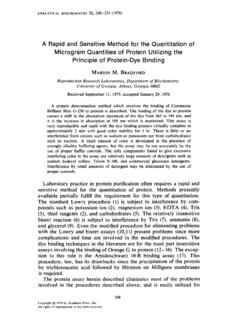Transcription of 00-305/1156 acryl.poly tn - Bio-Rad Laboratories
1 Electrophoresistech note 1156 Paul Menter, Bio-Rad Laboratories , 2000 Alfred Nobel Drive, Hercules, CA 94547 USAI ntroductionThe unparalleled resolution and flexibility possible with polyacrylamide gel electrophoresis (PAGE) has led to its widespread use for the separation of proteins and nucleicacids. Gel porosity can be varied over a wide range to meetspecific separation requirements. Electrophoresis gels andbuffers can be chosen to provide separation on the basis ofcharge, size, or a combination of charge and key to mastering this powerful technique lies in the polymerization process itself. By understanding the importantparameters, and following a few simple guidelines, the novicecan become proficient and the experienced user can optimizeseparations even bulletin takes a practical approach to the preparation ofpolyacrylamide gels.
2 Its purpose is to provide the informationrequired to achieve reproducible, controllable those users interested only in the bare essentials, thePolymerization Protocols can be used as a laboratory of PolymerizationPolyacrylamide gels are formed by copolymerization of acrylamide and bis-acrylamide ( bis, N,N'-methylene-bis-acrylamide). The reaction is a vinyl addition polymerization initiated by a free radical-generating system (Chrambach 1985).Polymerization is initiated by ammonium persulfate and TEMED(tetramethylethylenediamine): TEMED accelerates the rate offormation of free radicals from persulfate and these in turncatalyze polymerization. The persulfate free radicals convertacrylamide monomers to free radicals which react with unactivated monomers to begin the polymerization chainreaction (Shi and Jackowski 1998).
3 The elongating polymerchains are randomly crosslinked by bis, resulting in a gel witha characteristic porosity which depends on the polymerizationconditions and monomer (or riboflavin-5'-phosphate) may also be used as asource of free radicals, often in combination with TEMED andammonium persulfate. In the presence of light and oxygen,riboflavin is converted to its leucoform, which is active in initiating polymerization. This is usually referred to as photochemical Polymerization A Practical ApproachPolyacrylamide Gel PolymerizationPurity of Gel-Forming ReagentsAcrylamideGel-forming reagents include the monomers, acrylamide and bis,as well as the initiators, usually ammonium persulfate andTEMED or, occasionally, riboflavin and TEMED. On a molarbasis, acrylamide is by far the most abundant component in themonomer solution.
4 As a result, acrylamide may be the primarysource of interfering contaminants (Dirksen and Chrambach1972). Poor-quality acrylamide contains significant amounts ofthe following contaminants:1. Acrylic acid Acrylic acid is the deamidation product of acrylamide. Acrylic acid will copolymerize with acrylamide and bis, thereby conferring ion exchange properties on theresulting gel. This can lead to local pH changes in the gel andcause artifacts such as aberrant relative mobility, precipitation ofsome proteins and nucleic acids, streaking or smearing ofbands, and run-to-run irreproducibility. In acrylamide, acrylic acidshould be below (w/w). This is determined by directtitration, and supported by both conductivity and pH Linear polyacrylamide Contaminants with catalytic propertiesmay cause what appears to be autopolymerization during theproduction, processing, or storage of marginally pure results in the presence of linear polyacrylamide in the drymonomer.
5 Linear polyacrylamide will affect polymerization, since itserves as a nucleus for polymerization. The most important effectis the loss of reproducibility in gel porosity and relative mobilitiesof proteins and nucleic acids. Linear polyacrylamide is detectedas water or alcohol insolubles and should be < (w/w).CH2 CHCONH2CH2 CHCONHA crylamidePolyacrylamideBis+CH2 NHCHCH2CH2 CHCONH2CH2 CHCONHCH2 NHCOCHCOCH2 CHCONH2CH2 CHCONH2CH2CH2 CHCONH23. Ionic contaminants Ionic contaminants can include bothinhibitors and accelerators of polymerization. Aside fromacrylic acid, the most notable ionic contaminants are metalssuch as copper, which can inhibit gel polymerization. Metals can also poison enzymes, alter the relative mobility of metal binding proteins such as calmodulin, and inhibitdigestion of electrophoretically purified nucleic acids byrestriction and modification enzymes.
6 Ionic contaminants are detected indirectly by their effects on chemical and photochemical polymerization, and by the conductivity ofmonomer is present in much smaller quantities than acrylamide in monomer solutions. However, improperly purified bis contains some of the same contaminants as include products of autopolymerization and ionic contaminants, which have the same deleterious effects, andcan be detected in the same ways, as the correspondingacrylamide polymerization is initiated by ammonium persulfate,while photochemical polymerization is initiated by riboflavin (or riboflavin-5'-phosphate), or by a combination of riboflavinand ammonium persulfate. Initiation and polymerization are catalyzed by TEMED. Because polymerization is initiated bythe generation of free radicals from persulfate or riboflavin, it is not surprising that these compounds are reactive, andprone to oxidation or decomposition.
7 The contaminants ofthe initiators tend to be the products of their own breakdownas well as other contaminating is subject to oxidation, which causes the gradual loss of catalytic activity. This process is greatly accelerated by contaminating oxidizing agents. TEMED that containsoxidation products is characterized by a yellow color. Thepractical consequences of the oxidative process are therequirement for greater amounts of TEMED to achieve adequate polymerization, and a gradual loss of TEMED reactivity with time. TEMED is also very hygroscopic and willgradually accumulate water, which will accelerate oxidativedecomposition. TEMED with maximum activity and shelf life is obtained by redistillation immediately prior to bottling, resulting in a product that is clear, water free, and greaterthan 99% pure ( M).
8 Ammonium persulfate is also very hygroscopic. This propertyis particularly important, since ammonium persulfate beginsto break down almost immediately when dissolved in , the accumulation of water in ammonium persulfateresults in a rapid loss of reactivity. This is why ammoniumpersulfate solutions should be prepared fresh daily. Persulfateis consumed in the polymerization reaction. Excess persulfatecan cause oxidation of proteins and nucleic acids. This oxidation problem can be avoided if inhibitor-free gel-formingreagents are used, and ammonium persulfate is used at therecommended levels. Contaminants in BuffersContaminants in buffer reagents (Tris, borate, acetate, glycine, etc.), gel additives (SDS, urea, etc.), and laboratorywater can have a profound effect on polymerization.
9 Themost common contaminants of these reagents are metals,non-buffer ions, and breakdown products. The most frequenteffect of these contaminants is to inhibit polymerization. Whenpolymerization is partially inhibited, the resulting gel will havegreater porosity than intended, and molecules will havegreater mobilities. Furthermore, control over polymerizationreproducibility is Type and ConcentrationInitiators are the effectors of polymerization. Of course,the rateof polymerization depends on the concentration of initiators,but more importantly, the properties of the resulting gel alsodepend on the concentration of initiators. Increasing the concentration of initiators ( , ammonium persulfate andTEMED) results in a decrease in the average polymer chainlength, an increase in gel turbidity, and a decrease in gel elasticity.
10 In extreme cases, excess initiator can produce a gelsolution that does not appear to polymerize at all. This is dueto the formation of polymer chains so short that visible gelation does not take place and the polymer stays in only indication that a reaction has taken place is anincrease in ammonium persulfate and TEMED have other effects, including oxidation of sample proteins (especiallysulfhydryl-containing compounds) and changes in buffer TEMED can increase buffer pH, react with proteins(Dirksen and Chrambach 1972; Chrambach et al. 1976), and alter the banding pattern (Gelfi and Righetti 1981a).Ammonium persulfate acts as a buffer between pH 8 and persulfate is recommended instead of ammoniumpersulfate in weakly buffered basic systems (~pH 9). Excess riboflavin may cause the oxidation of some compounds, especially sulfhydryl-containing compounds(Dirksen and Chrambach 1972), and can denature proteins(Righetti et al.)

